Introduction
CONGRATULATIONS!
By purchasing the Seacraft modular battery, you will benefit from a very flexible and high-quality power cell for your Seacraft scooter.
This battery is a component for a Seacraft scooter. It was designed to be used only by persons trained in this field and having the appropriate diving certification obtained as a result of the completion of diving courses organized by authorized certification bodies.
In the event of a discrepancy between the rules for usig the battery set out in this manual, and used, developed or communicated to you in the course of training by diving organizations, please contact Seacraft (office@seacraft.eu) in order to explain it.
Before operating the Seacraft battery, carefully read this manual and follow all instructions given. Manual and proof of purchase should be retained, easily accessible after purchase.
The manufacturer reserves the right to change the specifications of the device without prior notice.
General safety rules
Warnings, labels and pictogramms on the battery
For the safe and proper use of the Seacraft battery every user is obliged to familiarize himself/herself with the warnings, labels and pictograms placed on the device.
The following is placed on the scooter:
 | Certified for air transport. Complies with UN 38.3 standards. |
 | Read the instruction before the use! Information on use in the manual! |
 | Important information! / Caution, danger! |
 | Li-ion batteries must be disposed of in accordance with all local and national regulations. If the batteries are not property disposed of, they could pose a risk to human health or the environment. |
 | After the service life, the device must not be placed along with other household waste. Device must be disposed of in accordance with applicable regulations! |
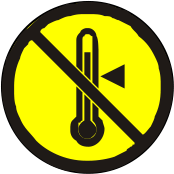 | Do not allow the battery to overheat! |
Using the battery safely
Below, only some elements related to the safety and use of the Seacraft batteries are presented:
- Please read the manual as it contains important precautions, warnings and information.
It is essential that it is carefully and fully read before using the battery. - The battery may only be used by persons with appropriate training in this field. It is strongly forbidden to use the battery without obtaining special qualifications for diving with a scooter.
- Using the battery for purposes other than those specified in this manual or in violation of the rules set out in this manual may result in serious personal injury or even death.
- When using a Seacraft battery different than the original battery built in the scooter, it is necessary to read the enclosed leaflet and instructions for use of the said battery.
- Never use or carry a battery showing signs of mechanical damage.
- Always check the level of the battery before entering the water.
- Use a battery charger in a manner inconsistent with the instructions in the user manual, in particular in conditions of high humidity or when the power cord is damaged may present a risk to the user’s health of life. Do not touch any part of scooter ‘s charger with wet hands.
- It is forbidden for children and adolescents under 18 years of age to use the battery, or to leave the device unattended.
- Before transporting the battery, ensure it is packed in a way that prevents it from damage during shipping. Remember to use the provided blind plugs, to secure the segment’s electrical connectors. For transporting the battery segments, it is recommended to use the optional Seacraft transport bag.
Specifications
The modular Seacraft battery is available with 2 different capacities, as stated below.
Modular Battery UM1700
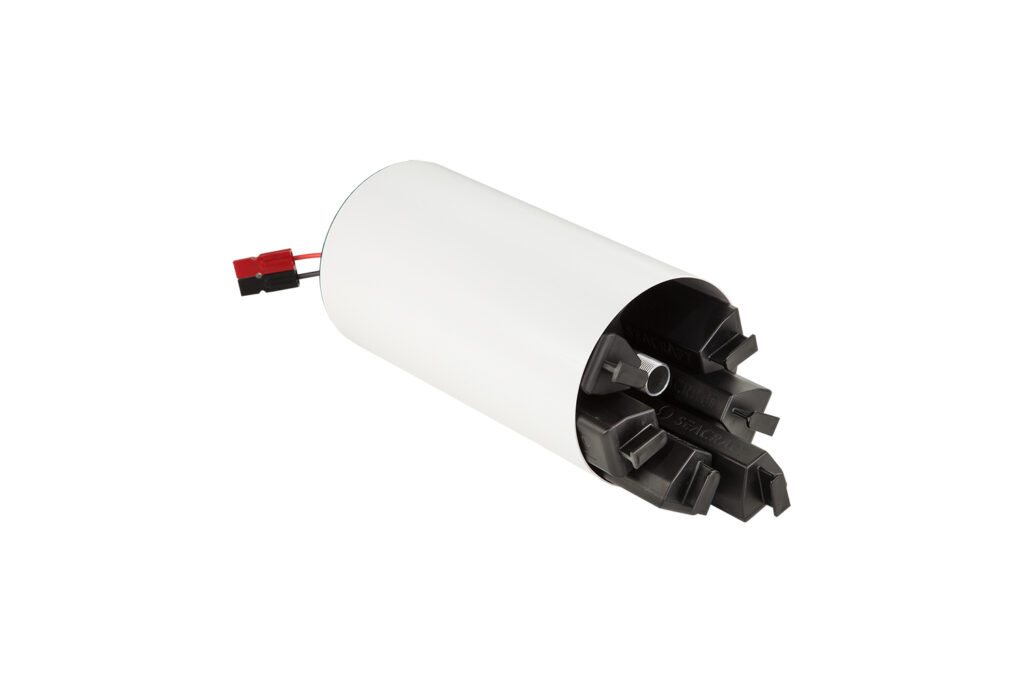
Battery
| Type | Li-Ion |
| Capacity | 582 Wh |
| Max. voltage | 37,5 V |
| Number of Segments (97 Wh each) | 6 |
Dimensions
| Length | 380 mm |
| Diameter | 150 mm |
| Weight | 4,58 kg |
Modular Battery UM1701
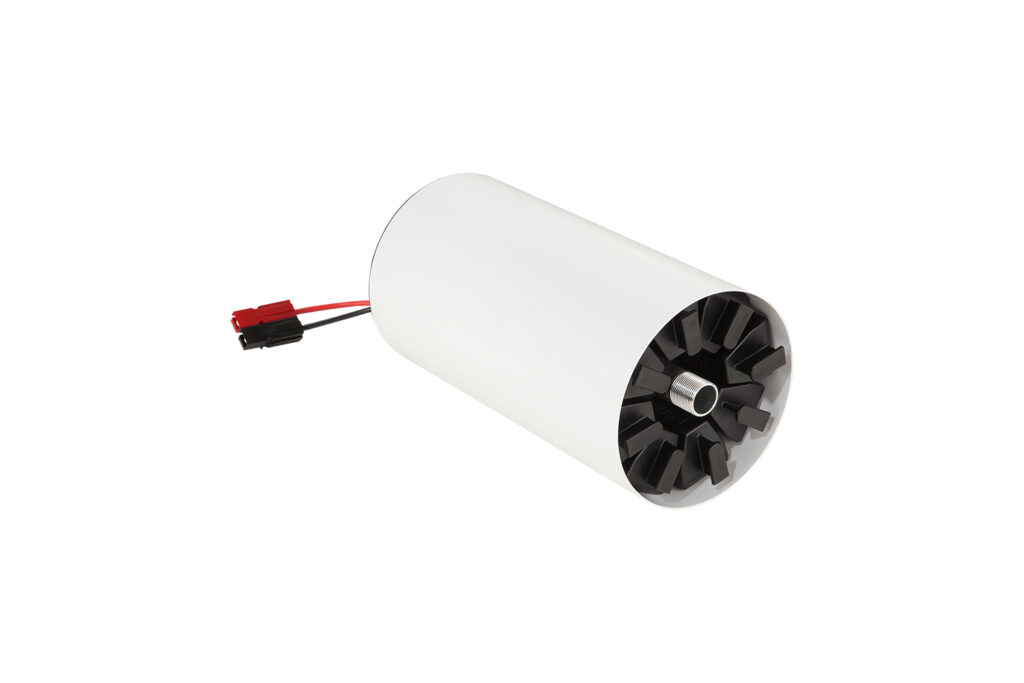
Battery
| Type | Li-Ion |
| Capacity | 780 Wh |
| Max. voltage | 37,5 V |
| Number of Segments (97 Wh each) | 8 |
Dimensions
| Length | 380 mm |
| Diameter | 150 mm |
| Weight | 5,66 kg |
Battery segment UM1810 with 97 Wh
Segment features
- Sealed segment body with notes and usage information
- Segment connection to plug into the battery housing
- Segment handle for pushing in/pulling out the segment
Segment specifications
| Type | Li-Ion |
| Capacity | 97 Wh |
| Max. voltage | 37,5 V |
| Length | 250 mm |
| Weight | 0,54 kg |
Using the battery
What to observe with the modular battery
With a standard scooter battery, all of the cells are normally inextricably connected to each other. Thus, charging and using such a battery means, that all cells are charged and discharged evenly and at the same time.
Now, one feature of the Seacraft modular battery is the possibility to dismantle it, in order to transport the extracted segments as hand luggage (if the chosen carrier permits this).
But this feature renders the user responsible for making sure, that all segments of a modular battery are charged and discharged evenly and at the same time.
While you may rest assured, that combining battery segments with different charging levels poses absolutely no risk or danger, this approach will confront you with the fact, that you will loose battery capacity temporarily. Therefore, when using a modular Seacraft battery, always remember the following:
Combining battery segments
If you combine battery segments form different sources (e.g. from different modular batteries or by adding new segments to an existing modular battery), it is recommended to assume, that these segments have a different charging level than the segments already in place.
Why is this important? Well, if the charging level of the battery segments differs by more than 0,5 V, the less-charged segments will be “blocked” and thus rendered inactive. This is a feature to protect the whole battery as a unit. An example:
You are using 4 segments, charged to 100 % and 2 segments charged to 50 % and 70 %. Your scooter will now have 4/6 of its nominal power, since 2 segments are “blocked”. When the 4 segments reach 70 % charging level, one segment will be “released”, so you have 5/6 of the battery’s nominal power available.

Checking the charging level of battery segments
As stated above, you need to be sure that the battery segments you combine in the battery hull provide a uniform charging level. To check the charging level, you may of course use a volt meter or (as a simple, but less precise approach while you are traveling) by the following method:
- Insert one battery segment at a time into the battery hull, and connect the modular battery to your Seacraft scooter.
- Switch on the scooter, and the battery indicator will show you the charging level of the inserted segment. If required, note the charging level.
- Switch off the scooter, disconnect the modular battery from the scooter, and remove the battery segment. Put the segment aside, and If required, place the note with the measured charging level with it.
- Repeat this procedure for the remaining battery segments.
Preparing the combined battery segments for use
In order to make sure, that all combined battery segments provide the same charging level, there is one procedure which will always work:
- Insert all segments into the battery hull (regardless of their charge level).
- Close the battery hull properly, and connect it to your Seacraft scooter.
- Close the scooter properly and place it in the water (select a suitable location, where the scooter can be run safe, without harming the environment or other people).
- Secure the scooter in place!
- Switch on the scooter, and select a moderate gear (max. gear [4]).
- Depending on the scooter’s configuration, press one or both steering handles, and lock them in place with a suitable fixation (e. g. bungees).
- Keep the scooter under observation and let it run, until the battery is discharged completely.
- If the scooter has stopped working, take it out of the water, and charge the modular battery as described in this manual. This will make sure, all segments are equalized and provide the same charging level. You may also ask a Seacraft service center for assistance.
Assembling / disassembling the battery
This chapter describes how to create a working modular battery from segments and how to take it apart for travelling.
Assembling the battery
Proceed as follows to assemble the battery:
- Make sure, the modular battery’s hull is disconnected from the scooter / charger and placed on a stable, flat and clean surface.
- Remove the trim weights from the battery, loosen and remove the cap’s center locking screw, by turning it counter-clockwise:
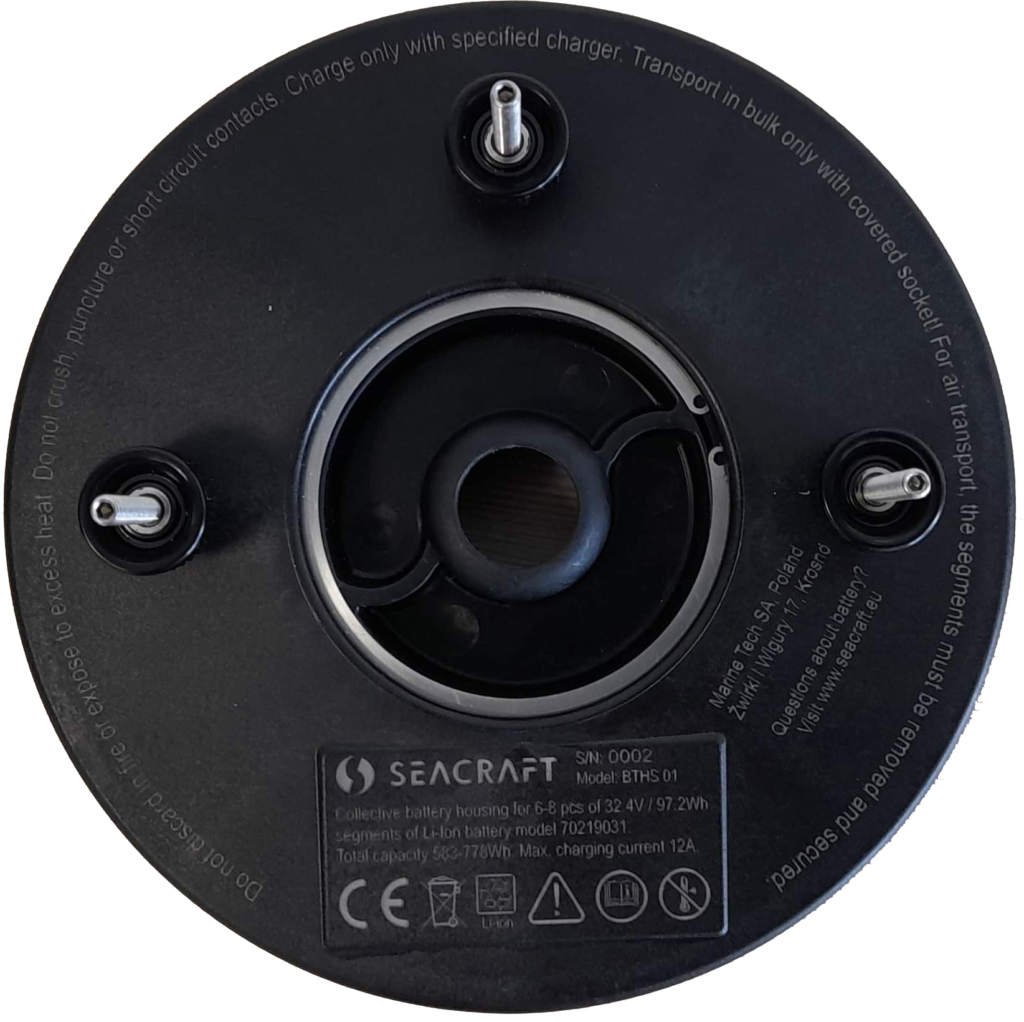
- Carefully open and remove the battery hull cap.
You will now see the inner parts of the battery hull (segment contacts and segment holders:
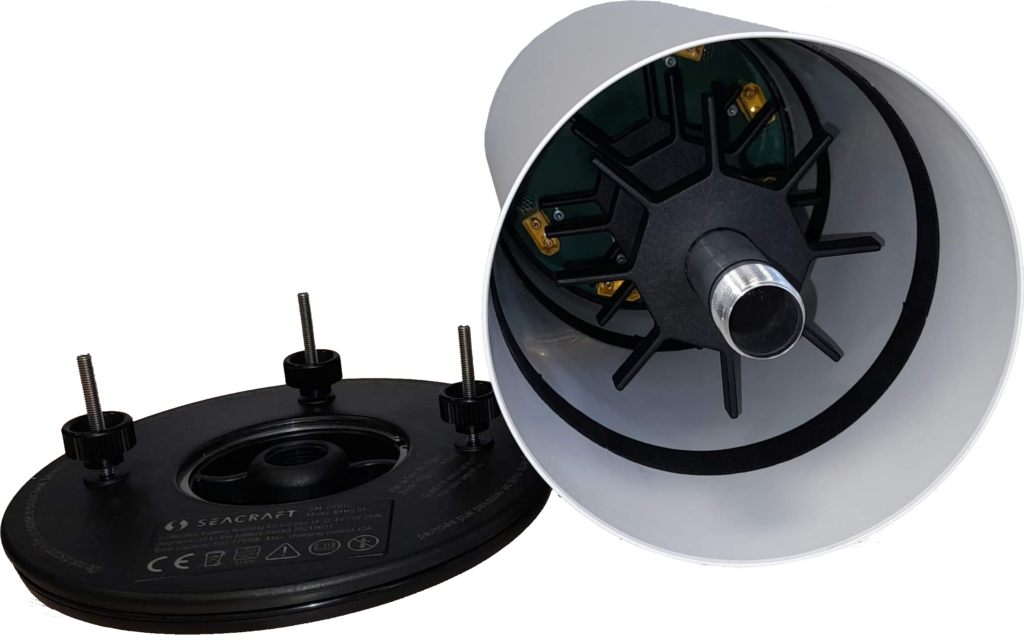
- The connectors of the battery segments are protected with a blind plug.
Remove this blind plug, and store it safely (e.g. in the transport bag).
- Align the segment connector with the matching connector in the battery hull, and push the battery segments one by one fully into the battery hull. There is no special sequence, in which the battery segments should be inserted, but if you use less than 8 segments, it is recommended to arrange the segments in a symmetrical way with the gap(s) on the upper side ), so the center of gravity is moved downwards).
This will support the “handles-up” position of your scooter under water.
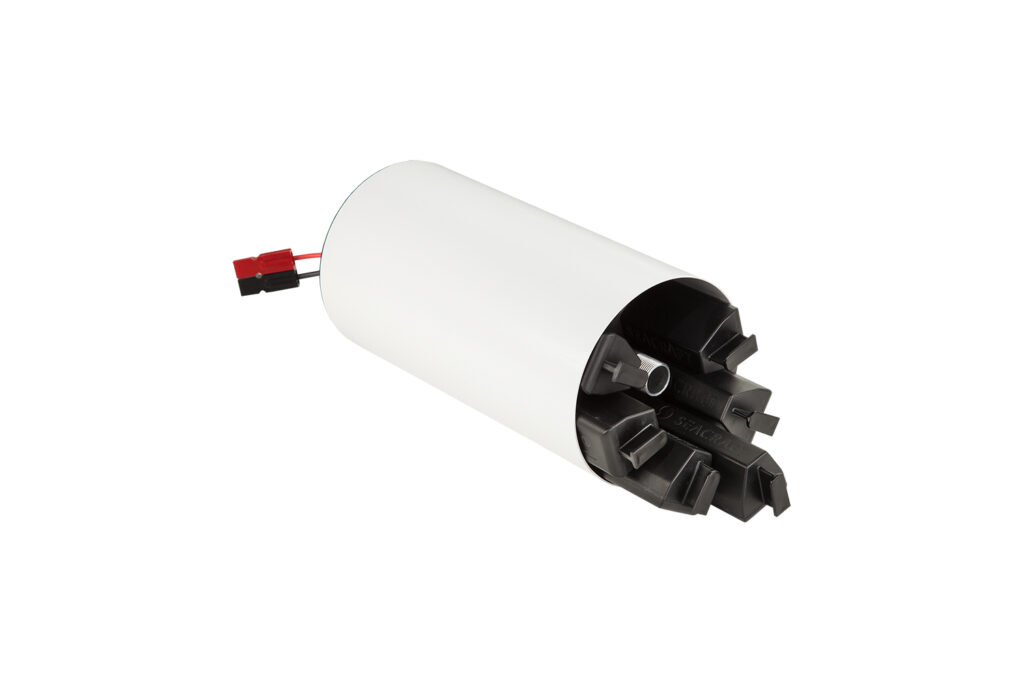
- If all segments are installed, inspect the cap o-ring, to make sure it is undamaged and free from dirt. Slightly lubricate the cap o-ring, if required.
- Close the battery hull cap, making sure not to squeeze the cap o-ring.
- Tighten the cap’s center locking screw by hand, and (if required) install the trim weights on the battery hull. If you use less than 8 battery segments, it is recommended to have the trimweights point to the lower side if the battery, so the center of gravity is moved downwards). This will support the “handles-up” position of your scooter under water.
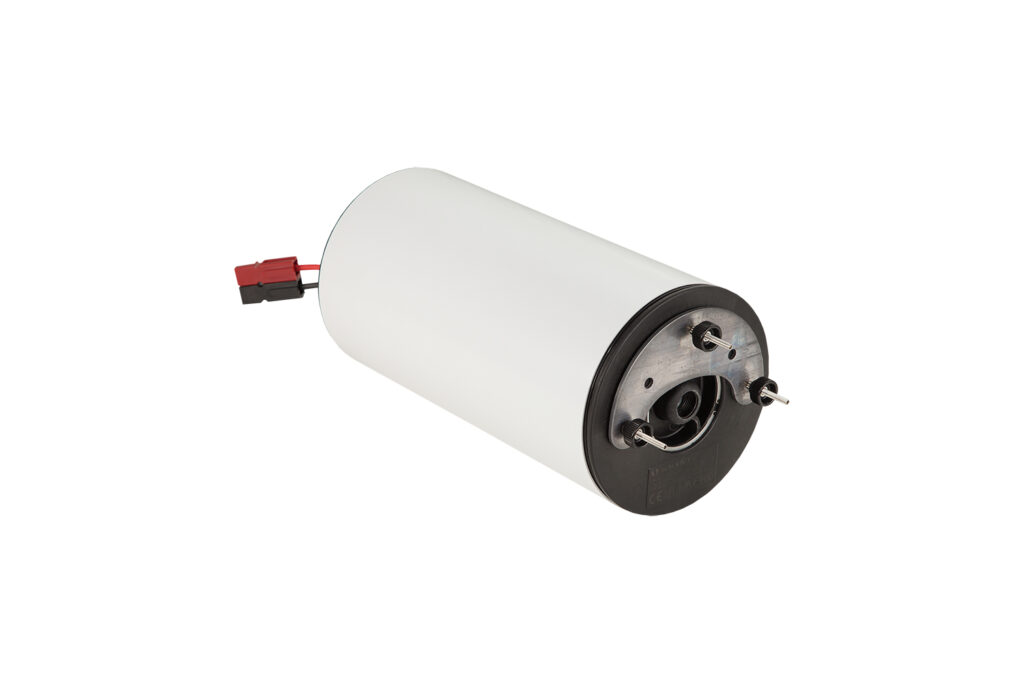
Proceed as follows, to install the modular battery in a Seacraft scooter:
- With the battery connector first, slide the modular battery onto the scooter’s center rod.
- Determine the correct battery position for your desired trim, and fix the battery on the axial rod, by using the provided clamp mechanisms.
- Connect the battery to the scooter.
- Close the scooter as described in the scooter user manual.
- If required: Select the correct battery model in the scooter configuration.
To do this, hold both scooter triggers down, and switch on the scooter.
If the start screen is displayed, release both triggers. Browse to the battery setup options, and select the correct setting for the modular battery. - Switch off and then switch on the scooter, in order to check the available battery capacity.
- If required continue with 4.3 “Charging the battery”, or close the scooter according to the instructions in the scooter manual to make it ready for diving.
Disassembling the battery
- Proceed as follows, to prepare your modular battery for travelling:
- Switch off and open your Seacraft scooter.
- Disconnect the modular battery from the scooter, loosen the securing clamp(s), and carefully slide it from the scooter’s axial rod.
- Place the modular battery on a stable, flat and clean surface.
- Inspect the battery hull for moisture, dirt and damages.
- If required, remove the trim weights from the battery hull.
It is recommended to note the number and weight of the used trim weights. - Loosen the center locking screw on the battery hull cap.
- Carefully remove the cap, and inspect the o-rings for contamination and damages. Then, put the cap aside.
- Firmly grab the handle of a battery segment, and pull it out of the battery hull.
- Inspect the battery segment and its connector for wear and damages.
- Protect the battery segment connector with a blind plug.
- Place the battery segment in the transport bag.
- Pull out and stow away the remaining battery segments in the same way.
- Check the inside of the battery hull for moisture, contamination, wear and damages.
- Close the battery hull cap, making sure not to squeeze the cap o-ring.
- Tighten the cap’s center locking screw by hand, and (if required) install the trim weights on the battery hull.
Charging the battery
The battery “lifetime” in a Seacraft scooter is estimated at approx. 300-400 cycles and a period of 3-4 years. After that period, the battery will continue to work, however its capacity may be reduced due to natural battery capacity decrease. To check precisely the condition of your battery, contact your closest service point.
Usage patterns of the scooter and battery charging affect its durability.
Adherence to the manufacturer’s guidelines guarantee an extended battery life and the safete scooter use.
Among other things, the battery charging time depends on the following factors:
- Charger model
- Remaining charge
- Battery state
- Ambient temperature
Please see the Seacraft support website for more detailed information about the battery lifetime:
support.seacraft.eu > FAQ > Scooters
Charging the battery outside the scooter
You may charge the modular battery by means of the optional charging adapter, which allows you to connect the charger directly to the battery. Proceed as follows:
- Check whether there are impurities or traces of moisture in the battery connector
(e.g. as a result of condensation of water vapor). Clean/dry the connector, if required. - Make sure, the charger is switched off, connect the charger to the power source
as specified for the charger, wait approx. 30 seconds for the charger to calibrate, then switch on the charger. - If the charger’s green LED is lit, connect the charger to the battery.
The charger’s fan will now start to spin. - Wait until the charger switches off at the end of che charging cycle.
- Disconnect the charger from the battery and the power source, and connect the battery to a scooter in order to check the charging level (see “Transporting the battery” below).
Charging the battery in the scooter
Charging the modular battery after installing it in a Seacraft scooter is more comfortable, since this allows you to constantly monitor the charging progress. Proceed as follows:
- Unscrew the scooter’s charging socket cap, and place it on the scooter’s main switch, to keep it safe.
- Check whether there are impurities or traces of moisture in the charging socket
(e.g. as a result of condensation of water vapor). Clean/dry the socket, if required. - Make sure, the charger is switched off, connect the charger to the power source as specified for the charger, wait approx. 30 seconds for the charger to calibrate, then switch on the charger.
- If the charger’s green LED is lit, connect the charger to the scooter’s charging socket.
- After starting the charging process the OLED display will show information about the percentage of battery charge level with voltage and charging current.
- If the battery is fully charged, switch off the charger, disconnect it from the battery and the power source.
- Check the condition of the seal, the cleanliness of the charging socket and the thread on the socket cap.
- Lubricate the seal with grease supplied by the manufacturer.
- Screw the cap into the charging socket until you feel a resistance.
Transporting the battery
Transporting the complete battery
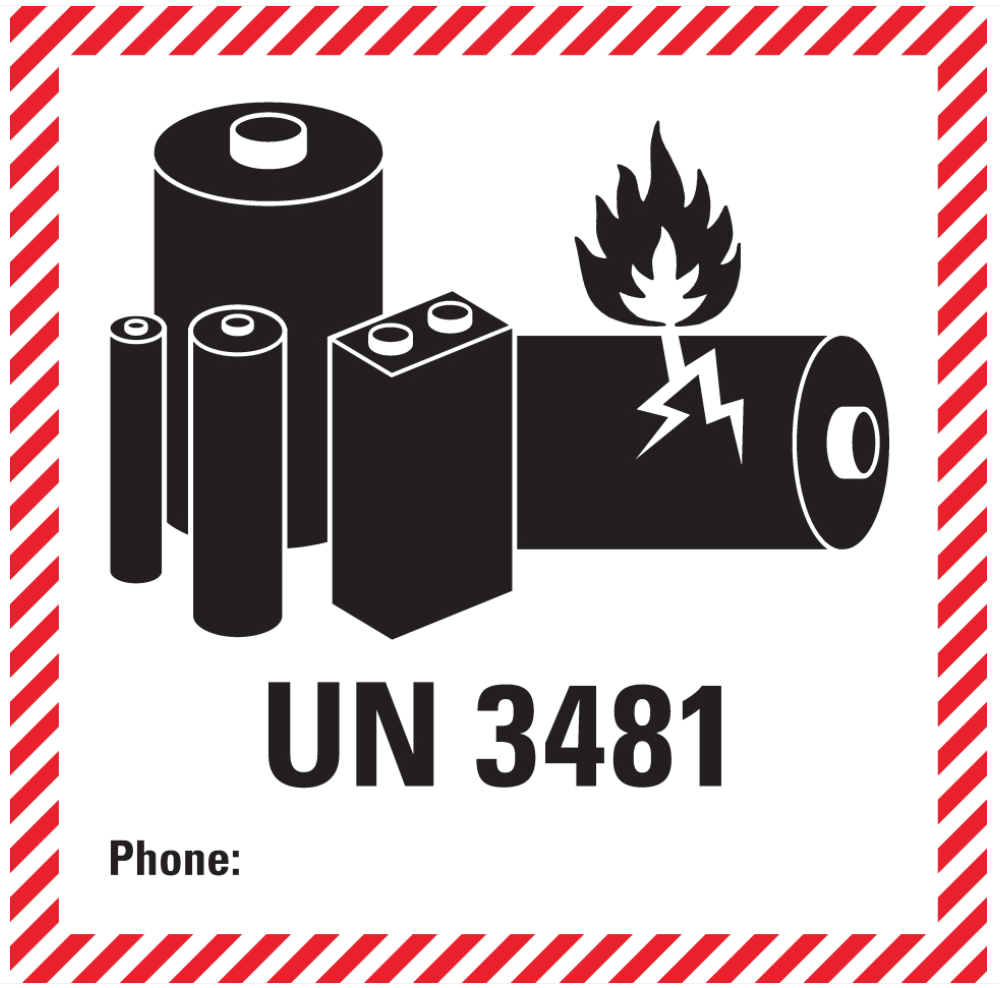 | In the case of transport by land, some restrictions for air and sea transport do not apply. Therefore, each time before sending packages containing the modular Seacraft battery, refer to local regulations for restrictions on the carriage of certain items or contact your carrier, distributor or the manufacturer of the scooter for detailed information on restrictions on transport of Li-Ion cells and batteries. |
Transporting battery segments
If you plan to transport the battery segments separately from the battery hull, dismantle the battery, as described above (4.5 / 4.6). it is recommended to use the optional Seacraft segment bag to keep all segments of one battery together.
If you are planning to fly with the battery segments, prepare for this.
> See our related support topic.
In any case, make sure that the segments are protected against mechanical damage, direct sunlight and other detrimental influences.
And – of course – do not forget to take the battery hull with you, too.
Storing the battery
The battery should be stored in a cool, dry place; the optimum storage temperature of the battery is approx. 10 °C. Storage of the battery at temperatures above 30 °C significantly reduces the battery’s lifetime.
It is forbidden to store the battery in places exposed to direct sunlight, in heated, closed and unventilated spacer (e.g. vehicles) and near heating appliances.
In case you can foresee, that the battery will not be used for 6 months or longer:
- Charge it to approx. 50%; this is the optimum charge level, which means the life of the battery decreases slowly.
- Dismantle the scooter by removing the housing cover (drawing 1, pos. 3) and detaching the battery from the scooter. Disconnecting the battery does not erase the data saved in the Seacraft scooter.
- In case the device is stored at high temperatures, under which the accelerated self-discharge is taking place, the user should check the battery level once a month, and in the case of discharge below 40 % recharge the battery to approx. 50 % of capacity.
- It is recommended that the first use of the battery (after more than six months of inactivity) to perform a full cycle of charging – discharging – charging. This will allow the calibration of the measurement system and to determine the battery condition and charge level.
If the scooter battery reaches a voltage lower than the critical value, please contact the manufacturer or the scooter distributor to verify whether it is possible to restore its functionality.
The decrease in battery capacity over time is a natural feature of all batteries, including Li-Ion batteries. The user should keep in mind that over time battery capacity is getting lower, which means that the maximum swimming time with the scooter on a charged battery is reduced. When planning a diving trip with a scooter the user should take into account the wear and tear of the battery.
Disposing of the battery
 | The battery is a product, which after use becomes waste, hazardous to people, animals and the environment. It is prohibited to place used batteries in containers for domestic waste. |
 | The used battery is recyclable and should be disposed of in properly labeled containers, dedicated to specialized points of receiving the used electronics, returned to the manufacturer or scooter supplier. |
Troubleshooting
In this chapter, you will find solutions for the most frequent problems in connection with using the Seacraft modular battery.
In case, your problem is not listed here, please visit our support website on
https://support.seacraft.eu. Here, you will find additional information, and you may create a service ticket, so we can help you.
Problem scenarios
| PROBLEM | POSSIBLE CAUSE | SOLUTION |
| My modular battery is depleted very quickly. | You might have combined segments with different charging levels in one battery. Now, at least one battery segment might be locked. | Make sure, all battery segments have been inserted correctly into the battery hull. Fully discharge and re-charge the complete battery. |
| My scooter behaves strangely: I can use it in lower gears, but it turns off when I select a higher gear. | You are not getting the full battery power, because at least one battery segment has a lower charging level than the others (blocked segment). | Make sure, all battery segments have been inserted correctly into the battery hull. Fully discharge and re-charge the complete battery. |
| I fully discharged and charged my modular battery, but the capacity displayed on my scooter control module does not seem to match. | You might have forgotten to enter the correct battery capacity (582 Wh or 780 Wh) into your scooter configuration. Please note, that you need at least firmware version 4.0 for this. | Enter the correct value into your scooter configuration. If required: Have your scooter firmare updated. |
| If you are using your scooter in very cold environments, it is a physical property of Li-Ion batteries, that their capacity will be reduced. This process is reversible: As soon as the battery has warmed up (e.g. due to changing ambient temperature), its capacity will be restored. | ||
| The battery will not charge. | The battery is not connected to the charger. | Check the charger fuse, and make sure that contacts, plug, socket and charger are clean. |
| The battery voltage is too low. | Measure the voltage at the battery terminals. If it is lower than specified as minimum for the type of battery, contact the service. | |
| The battery is damaged. | Contact the service. | |
| Under water, the handles of my scooter do not point upwards. | The modular battery with 8 segments has no defined low center of gravity, as the Seacraft standard batteries. You may have placed the battery and(or the trim weights incorrectly (center of gravity being not directed down) |

